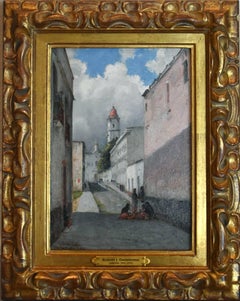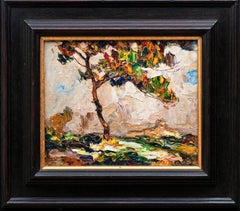John Wesley Hardin
1910s Impressionist Landscape Paintings
Oil
People Also Browsed
Antique Late 19th Century English Victorian Card Tables and Tea Tables
Lacquer
1920s Post-Impressionist Landscape Paintings
Oil, Panel
19th Century Academic Nude Paintings
Oil
Early 1900s Impressionist Landscape Paintings
Oil
1910s Impressionist Landscape Paintings
Oil
20th Century Portrait Paintings
Oil
19th Century Figurative Paintings
Oil
Early 1900s Figurative Paintings
Oil
Early 20th Century Post-Impressionist Landscape Paintings
Watercolor, Gouache, Archival Paper
1910s American Impressionist Landscape Paintings
Canvas, Oil
Late 18th Century Old Masters Figurative Paintings
Canvas, Oil
Antique 1740s Mexican American Colonial Cabinets
Wood
1910s Impressionist Landscape Paintings
Oil
1860s Paintings
Oil
Antique Late 19th Century French Busts
Marble, Bronze
19th Century Academic Landscape Paintings
Oil
Robert Jenkins Onderdonk for sale on 1stDibs
Robert Onderdonk is considered the "Dean" of Texas Painters. Onderdonk was born in Catonsville, Maryland in 1852. He received an academic education at the College of St. James, Catonsville, followed by studies at the National Academy of Design in 1872 under the instruction of Lemuel Everett Wilmarth. In 1875, Onderdonk attended Art Students League of New York and received instruction from Walter Shirlaw, James Carroll Beckwith and William Merritt Chase. Onderdonk moved to San Antonio, Texas in 1878, where he made a living teaching and selling his paintings. In 1889, he moved to Dallas, where he painted several portraits for the Hubert Portrait Company, followed by employment with the Art Students League of Dallas. In 1896, Onderdonk returned to San Antonio, Texas, where he continued to paint until he died in 1917.
Onderdonk was a member of the Allied Artists of America; Salmagundi Club, New York and the San Antonio Art League. He had a very thorough academic education and was always sketching family members, classmates and landscapes on the back of his school books. This sketching ethic was a process he subscribed to his entire life, always carrying a sketchbook with him wherever he went, like a camera of today. Deciding to make art his profession, Onderdonk moved to New York. He was not only a part of the academic beginnings of American art while studying in New York at the renowned National Academy of Design in 1870, but also one of the first student members, under the instruction of Lemuel Everett Wilmarth, at the Arts Students League. At the League, Onderdonk also studied and honed his craft with other teachers including Walter Shirlaw, William Merritt Chase and James Carroll Beckwith. Some of his classmates include George Inness, Jr. Frederick Stuart Church, John Henry Twachtman and a Texan from San Antonio named Edward Grenet. Onderdonk was lured to Texas in 1879 by his childhood friend and rancher, William Negely and by stories, he read in the tabloids of the day that touted Texas as the Promised Land.
Onderdonk found the light, people and atmosphere of San Antonio agreeable and quickly settled in. He soon met a fellow Texas artist, Emily Gould, whom he married in 1881. They lived with her parents in a house called "Bella Vista" throughout their lives. The house was two miles north of town and had a wonderful view of the city and still stands today. Here Onderdonk lived and taught art classes, painted portrait commissions, landscapes, still lifes and supported his family. Some of his students, who later became well-known Texas artists, were Mary Bonner, Seymour Thomas, Edward D. Eisenlohr, and Rolla Taylor. Onderdonk worked hard and encouraged his students to do their best. He was part of and organized several of the first art clubs in Texas, further helping to develop an interest in Texas art in the State and nationwide but also giving Texas and American artists places to display their works, win awards and achieve much needed recognition. He helped organize "The Brass Mug Club," a revered group of San Antonio artists that met on Sundays to enjoy friendship and go into the Texas Hill Country and paint. Members included Julian Onderdonk (Robert's son), José Arpa, Leo Cotton, Rolla Taylor, Tom Brown and Ernst Raba. In 1912, Onderdonk and Julian were involved in the organization of the San Antonio Art League, the first important art organization in Texas with the mission to establish a free public gallery in San Antonio with exhibitions, lectures and classes in art. Later, larger exhibitions that needed more room due to the extreme popularity of the League and its awards were held at the Witte Museum in San Antonio.
While living in Dallas from 1889–95, and in order to obtain commissions, Onderdonk organized the first Dallas art school, the Dallas Arts Students League, where he was president and instructor. In 1905, Onderdonk was chosen to select artists from New York and Texas to be represented and judged at the Dallas Fair, which later became the State Fair of Texas. In 1901, Onderdonk was commissioned by well-known Texas historian and writer, James T. DeShields, to paint a large historic painting of the Alamo battle. He used his family, friends and fellow artists for this painting, including his son. Onderdonk even put himself in the painting, as one of the Alamo Defenders, taking a mortal shot from the enemy and falling backwards. The painting took three years to complete. The Fall of The Alamo was first exhibited at the St. Louis World’s Fair in 1904. Among Onderdonk's important commissions were the illustrations he provided for feared Texas gunfighter John Wesley Hardin's autobiography, The Life of John Wesley Hardin, published in 1896. This was a courageous task by Onderdonk considering that Hardin, who had killed over 40 men was the fastest gun in the West, East, North or South. When Onderdonk died in 1917 at the age of 65 at his home in San Antonio, he was known as the dean of Texas artists. His contributions to Texas art and the early artists of Texas were well-known and well-respected. Written by Peter C. Rainone, as published in American Art Review, June 2008. Onderdonk was educated at the College of St. James in Maryland, where his father was headmaster.
At 20, he studied for two years at the National Academy of Design, under Wilmarth, then at the Art Students League under Shirlaw and Beckwith. He was the private pupil of A H Warren, a tonalist painter known as "the Corot of America." In 1878, he concluded his art studies with William Merritt Chase. To earn funds for a European trip he never made, Onderdonk was persuaded to establish his studio in San Antonio in 1878. By 1881, he was married, living near Pedro Spring and taking the mule car to his studio in the city. He always carried with him a wood panel such as the top of a cigar box so he could paint small scenes. For his studio classes, he charged $3 per month. He moved to Dallas in 1889, when offered $100 a month to teach. After his father-in-law died in 1896, he returned to San Antonio, where he remained except for a trip to St. Louis in 1899 to try commercial painting on tile. Not ambitious, not robust, not careful in signing his paintings, he received commissions for hundreds of portraits without being able to earn a suitable living. Even his epic Davy Crockett's Last Stand brought him only to say, "No one cares for historical pictures."
A Close Look at impressionist Art
Emerging in 19th-century France, Impressionist art embraced loose brushwork and plein-air painting to respond to the movement of daily life. Although the pioneers of the Impressionist movement — Claude Monet, Edgar Degas, Paul Cézanne, Berthe Morisot, Camille Pissarro, and Pierre-Auguste Renoir — are now household names, their work was a radical break with an art scene led and shaped by academic traditions for around two centuries. These academies had oversight of a curriculum that emphasized formal drawing, painting and sculpting techniques and historical themes.
The French Impressionists were influenced by a group of artists known as the Barbizon School, who painted what they witnessed in nature. The rejection of pieces by these artists and the later Impressionists from the salons culminated in a watershed 1874 exhibition in Paris that was staged outside of the juried systems. After a work of Monet’s was derided by a critic as an unfinished “impression,” the term was taken as a celebration of their shared interest in capturing fleeting moments as subject matter, whether the shifting weather on rural landscapes or the frenzy of an urban crowd. Rather than the exacting realism of the academic tradition, Impressionist paintings, sculptures, prints and drawings represented how an artist saw a world in motion.
Many Impressionist painters were inspired by the perspectives in imported Japanese prints alongside these shifts in European painting — Édouard Manet drew on ukiyo-e woodblock prints and depicted Japanese design in his Portrait of Émile Zola, for example. American artists such as Mary Cassatt and William Merritt Chase, who studied abroad, were impacted by the work of the French artists, and by the late 19th century American Impressionism had its own distinct aesthetics with painters responding to the rapid modernization of cities through quickly created works that were vivid with color and light.
Find a collection of authentic Impressionist art on 1stDibs.
Finding the Right landscape-paintings for You
It could be argued that cave walls were the canvases for the world’s first landscape paintings, which depict and elevate natural scenery through art, but there is a richer history to consider.
The Netherlands was home to landscapes as a major theme in painting as early as the 1500s, and ink-on-silk paintings in China featured mountains and large bodies of water as far back as the third century. Greeks created vast wall paintings that depicted landscapes and grandiose garden scenes, while in the late 15th century and early 16th century, landscapes were increasingly the subject of watercolor works by the likes of Leonardo da Vinci and Fra Bartolomeo.
The popularity of religious paintings eventually declined altogether, and by the early 19th century, painters of classical landscapes took to painting out-of-doors (plein-air painting). Paintings of natural scenery were increasingly realistic but romanticized too. Into the 20th century, landscapes remained a major theme for many artists, and while the term “landscape painting” may call to mind images of lush, grassy fields and open seascapes, the genre is characterized by more variety, colors and diverse styles than you may think. Painters working in the photorealist style of landscape painting, for example, seek to create works so lifelike that you may confuse their paint for camera pixels. But if you’re shopping for art to outfit an important room, the work needs to be something with a bit of gravitas (and the right frame is important, too).
Adding a landscape painting to your home can introduce peace and serenity within the confines of your own space. (Some may think of it as an aspirational window of sorts rather than a canvas.) Abstract landscape paintings by the likes of Korean painter Seungyoon Choi or Georgia-based artist Katherine Sandoz, on the other hand, bring pops of color and movement into a room. These landscapes refuse to serve as a background. Elsewhere, Adam Straus’s technology-inspired paintings highlight how our extreme involvement with our devices has removed us from the glory of the world around us. Influenced by modern life and steeped in social commentary, Straus’s landscape paintings make us see our surroundings anew.
Whether you’re seeking works by the world’s most notable names or those authored by underground legends, find a vast collection of landscape paintings on 1stDibs.


